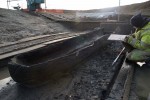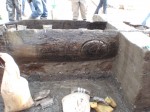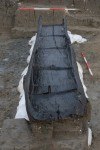 The eight Bronze Age log boats found preserved whole in the Cambridgeshire fens at Must Farm Quarry in Whittlesey, southeast England, have been moved to the museum in Flag Fen for conservation. Must Farm is the site of the largest find of Bronze Age artifacts ever made in Britain. Thousands of artifacts — jewelry, weapons, textiles, long woven eel traps, fish weirs, a charred platform bridge, bowls of nettle stew — around 3,500 years old were unearthed in 2011, a rich slice of Bronze Age life along a river channel. The most dramatic of the finds were the eight log boats, canoes dug out of whole ash and oak trunks. It’s rare for even one whole Bronze Age boat to survive, but the cozy anoxic environment of the silt and peat fen preserved these eight. Most of them are almost completely intact, with decorative elements, lifting handles and transom grooves still extant.
The eight Bronze Age log boats found preserved whole in the Cambridgeshire fens at Must Farm Quarry in Whittlesey, southeast England, have been moved to the museum in Flag Fen for conservation. Must Farm is the site of the largest find of Bronze Age artifacts ever made in Britain. Thousands of artifacts — jewelry, weapons, textiles, long woven eel traps, fish weirs, a charred platform bridge, bowls of nettle stew — around 3,500 years old were unearthed in 2011, a rich slice of Bronze Age life along a river channel. The most dramatic of the finds were the eight log boats, canoes dug out of whole ash and oak trunks. It’s rare for even one whole Bronze Age boat to survive, but the cozy anoxic environment of the silt and peat fen preserved these eight. Most of them are almost completely intact, with decorative elements, lifting handles and transom grooves still extant.
The artifacts provide a unique glimpse into a Bronze Age fishing village established on the River Nene when water levels began to rise. When the area first began to get soggy around 4,000 years ago, people left the flooding lowlands, but it seems they began to return 500 or so years later, figuring out how to live in the new wetlands. They built a causeway and the log boats to navigate the submerged land their ancestors had walked.
 Thanks to the same technology used to conserve the Tudor warship Mary Rose and the 17th century Swedish warship Vasa, the log boats will remain whole. In the past, conservators have had to cut these kinds of canoes into sections to dry them evenly. To ensure these precious artifacts be kept whole, a cold storage facility has been built to house them. The vessels, still waterlogged from more than 5,000 years in the fen, will be treated for two years with polyethylene glycol (PEG). The PEG will gradually replace the water in the wood with a waxy substance, drying out the boats slowly while keeping them from cracking, warping and shrinking.
Thanks to the same technology used to conserve the Tudor warship Mary Rose and the 17th century Swedish warship Vasa, the log boats will remain whole. In the past, conservators have had to cut these kinds of canoes into sections to dry them evenly. To ensure these precious artifacts be kept whole, a cold storage facility has been built to house them. The vessels, still waterlogged from more than 5,000 years in the fen, will be treated for two years with polyethylene glycol (PEG). The PEG will gradually replace the water in the wood with a waxy substance, drying out the boats slowly while keeping them from cracking, warping and shrinking.
While this process is ongoing, visitors to Flag Fen museum will be able to observe the boats and conservators doing their thing.
Visitors to Flag Fen will be able to watch conservators at work, with the aim of eventually putting the boats on public display in glass cabinets.
Ian Panter, principal conservator at the York Archaeological Trust, designed the conservation strategy for the boats.
He said: “It’s the first time we’ve had this number of log boats on one site.
“To undertake the conservation with the public able to view it and watch the process develop over the next few years is a great opportunity to see it in action.
“We’re keeping the boats wet and cold to help keep everything as it is – so there’s no biological activity to digest through the timber – to reduce decay of the wood.”
 Experts hope to answer more questions about the boats during conservation. They will be radiocarbon dated and analyzed in detail to determine when exactly they were made and why they were left in the river that became the fen. They’re in such good condition it’s possible they were deliberately sunk for ritual or ceremonial purposes. On the other hand, they may have just washed up at this point in the ancient River Nene or they have been abandoned under duress.
Experts hope to answer more questions about the boats during conservation. They will be radiocarbon dated and analyzed in detail to determine when exactly they were made and why they were left in the river that became the fen. They’re in such good condition it’s possible they were deliberately sunk for ritual or ceremonial purposes. On the other hand, they may have just washed up at this point in the ancient River Nene or they have been abandoned under duress.
For zoomable pictures of the Must Farm artifacts, see the extensive picture gallery on the website dedicated to the finds.
Just wanted to let you know how much I enjoy your site!
That is really cool! I am especially impressed by the iron sword displayed on the link you gave. It looks like it’s ready to sharpen and use again without any further ado! Though the handle looks rather small for most people…I guess people were a good bit smaller back then…